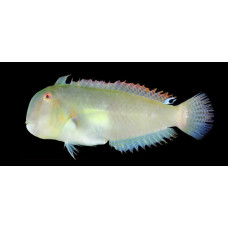Latin name
Iniistius bakunawa
Other names
Iniistius bakunawa
Identification
Has a flat body covered with reflective scales. These fish have small mouths but very strong teeth. This species can be distinguished from its congeners by the following features 7 horizontal rows of scales on the cheek; GR: 4-6 + 8-11 = 12-17; gill stamens short, with teeth; and tubular lateral scales 23-26; 2 scales on the back of the gill head.
Features of fish fins
The species was named "bakunawa" after a dragon-like creature in Visayan mythology that could cause an eclipse by devouring the moon. The name was given because of the eclipse-like markings on its dorsal fin, which resemble a total solar eclipse.
Fish colouring
Head and body pale yellowish to jade green with a large black and white concentric ellipsoidal eye on the posterior edge of the dorsal fin.
Distribution
Indo-West Pacific: Philippines and Western Australia.
Habitat
Marine tropical reef associated species. Depth range 54-57 m.
Size
Maximum length: 16.2 cm.
Behavior
They live in sandy areas where they use their steep forehead to dive into the sand and burrow when threatened. They are solitary creatures, often living alone and rarely seen in groups. They are diurnal.
Food and feeding habits
They are carnivorous and feed on invertebrates.
Reproduction
The female releases unfertilized eggs into the water, the male also releases sperm into the water. The released sperm seeks out the eggs and fertilizes them so that wrasse can grow from them.
Fishing
Catching guban is not recommended, but in many regions they are served as a delicacy.
Relationship with a person
A species of fish that is harmless to humans.
| Classification | |
| Phylum | Chordata |
| Class | Actinopterygii |
| Squad | Labriformes |
| Family | Labridae |
| Genus | Iniistius |
| Species | I. bakunawa |
| Features | |
| Conservation status | Not Evaluated |
| Habitat | Pelagic |
| Life span, years | No information |
| Maximum body weight, kg | No information |
| Maximum length, cm | 16,2 |
| Sailing speed, m/s | No information |
| Threat to people | Edible |
| Way of eating | Predator |

